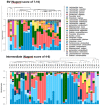Effect of Oral Probiotic Lactobacillus rhamnosus GR-1 and Lactobacillus reuteri RC-14 on the Vaginal Microbiota, Cytokines and Chemokines in Pregnant Women
- PMID: 32019222
- PMCID: PMC7071157
- DOI: 10.3390/nu12020368
Effect of Oral Probiotic Lactobacillus rhamnosus GR-1 and Lactobacillus reuteri RC-14 on the Vaginal Microbiota, Cytokines and Chemokines in Pregnant Women
Abstract
Spontaneous preterm birth is associated with vaginal microbial dysbiosis. As certain strains of lactobacilli help restore homeostasis in non-pregnant women, the goal was to determine the effect of Lactobacillus rhamnosus GR-1 and Lactobacillus reuteri RC-14 administered orally, twice daily for 12 weeks on the vaginal microbiota, cytokines and chemokines of low-risk pregnant women. A double-blind, placebo-controlled, randomized trial comparing probiotic lactobacilli to placebo daily was performed in 86 asymptomatic pregnant women who had an Intermediate or Bacterial Vaginosis Nugent score at 13 weeks. After drop outs, 32 women receiving probiotics and 34 receiving placebo completed the study. The Nugent score returned to normal in 30% of the women in both groups at 28 weeks and was maintained until 35 weeks. The majority of subjects had normal pregnancy outcomes. Ninety-three bacterial species were detected at 13 weeks, with Lactobacillus iners, Lactobacillus crispatus, Gardnerella vaginalis and Atopobium vaginae being the most abundant across pregnancy. There was no difference in the Shannon diversity index between the probiotic and placebo groups at 13, 28 or 35 weeks. Almost all subjects consumed fermented foods and many of the organisms in the vagina are also known to be present in fermented foods. Interleukin-4 in the placebo group and Interleukin-10 in both probiotic and placebo groups increased slightly at 28 weeks but were not different at 35 weeks when compared to 13 weeks. In conclusion, this study showed no adverse issues resulting from 12 week use of probiotic Lactobacillus strains GR-1 and RC-14 during pregnancy in women at low risk for premature birth. The vaginal microbiota demonstrated flux irrespective of this oral probiotic administration.
Keywords: bacterial vaginosis; chemokines; cytokines; microbiota; pregnancy; probiotics.
Conflict of interest statement
The authors declare no conflict of interest.
Figures






References
-
- Donders G.G., Van Calsteren K., Bellen G., Reybrouck R., Van den Bosch T., Riphagen I., Van Lierde S. Predictive value for preterm birth of abnormal vaginal biota, bacterial vaginosis and aerobic vaginitis during the first trimester of pregnancy. Br. J. Obstet. Gynecol. 2009;116:1315–1324. doi: 10.1111/j.1471-0528.2009.02237.x. - DOI - PubMed
-
- McMillan A., Rulisa S., Sumarah M., Macklaim J.M., Renaud J., Bisanz J.E., Gloor G.B., Reid G. A multi-platform metabolomics approach identifies highly specific biomarkers of bacterial diversity in the vagina of pregnant and non-pregnant women. Sci. Rep. 2015;21:14174. doi: 10.1038/srep14174. - DOI - PMC - PubMed
Publication types
MeSH terms
Substances
Grants and funding
LinkOut - more resources
Full Text Sources
Other Literature Sources
Medical
Research Materials

